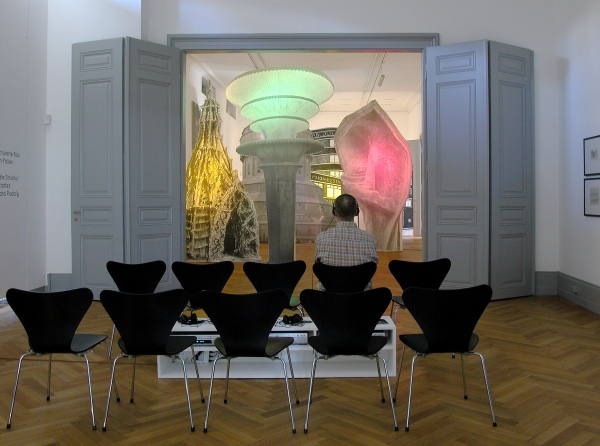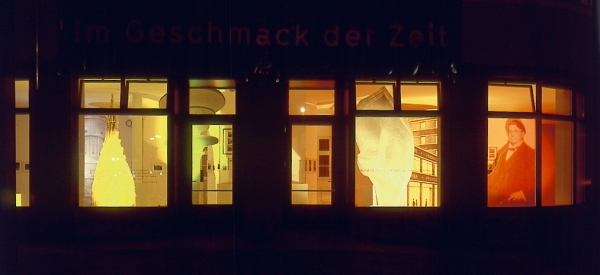
Installation view, Architekturmuseum Basel, 2004.
Installation view, Architekturmuseum Basel, 2004.
External view, Weydinger Strasse 20, Berlin, 2003.
Installation view, Johann-Wolfgang-Goethe-Universität, Frankfurt am Main, 2004.
Installation view, Johann-Wolfgang-Goethe-Universität, Frankfurt am Main, 2004.
Im Geschmack der Zeit – das Werk von Hans und Marlene Poelzig
3 October – 20 December 2003
Weydinger Strasse 20, Berlin
11 March – 23 April 2004
IG Farben, Johann-Wolfgang-Goethe-Universität, Frankfurt am Main
11 September – 14 November 2004
Architekturmuseum Basel
– Stage set with five architectural fragments, theater spotlights
– Poelzig Serie, 2003, 24 photographs, passe-partout, framed; each 19 x 15 inches
– Im Geschmack der Zeit, 2003, video, 16 min., camera: Madeleine Bernstorff
– Im Geschmack der Zeit, 2003, CD, 34:20 min.
– Filmkunsthaus Babylon, 2003, CD, 24:41 min.
– Rosa-Luxemburg-Platz und Bebauung Babylonblock, 2003, CD, 70:40 min.
– Various plans, documents, and photographs by Hans and Marlene Poelzig
Verein zur Förderung von Kunst und Kultur am
Rosa-Luxemburg-Platz e. V.
In his exhibition, Christian Philipp Müller installed a panorama of the work of architect Hans Poelzig and his wife Marlene. Müller had the stage sets equipped with different lighting for day and night — visitors moved through Poelzig’s architecture, through his installations for theater and film, and along the stations of his life.
The house on Weydingerstrasse was one of seven buildings Poelzig designed and partially realized in the nineteen-twenties as part of the overall design of Rosa-Luxemburg-Platz. In context of the renovation of the structure, Müller was commissioned to develop a tribute to Poelzig’s work. In the exhibition space, visitors progressed through six “chapters” devoted to: the architect’s teaching activities, his industrial architecture, his applied art and decorative works, and his productions for theater and film. The fifth chapter showed the block structure at Rosa-Luxemburg-Platz as originally planned, and the sixth concluded with a representation of Poelzig’s life, his world, and his closest collaborator and wife Marlene. Each act was arranged as a stage set against which Poelzig himself appeared in over-life-size form along with such items as photos of his sketches for an unrealized majolica chapel or sets from the feature film, “Der Golem, wie er in die Welt kam” (1920). The backs of these set pieces showed sketchbooks from the family estate and original designs, along with contemporaneous photographs and literature related to the works discussed. In addition to his primary activity as architect, furniture designer, stage set designer, and film artist, Poelzig also thought of himself as a painter.
In preparation for the exhibition, Müller traced Poelzig’s activities in a journey from Berlin to Breslau (now Wrocław) in Poland, with many intermediary stops, a journey that resulted in a video shown at the exhibition. Müller visited Poelzig’s buildings and, standing in front of them, quoted from historical works on his oeuvre. The visible contrast in the film between the texts and the current condition of the buildings was further intensified by a photo series showing Poelzig’s buildings in their present environment. In the exhibition space, texts and images were combined with audio recordings of excerpts from interviews Müller conducted with residents, descendents, architects, and film and architectural historians. In addition, a Poelzig film series, curated by Madeleine Bernstorff, was shown in the movie theater, Kino Babylon, on Rosa-Luxemburg-Platz, a structure also built by Poelzig.
In the exhibition itself, visitors encountered less of an arrangement of artistic artifacts than of a rediscovered world — an effect further intensified in the night version of the exhibition. Illuminated by stage lights in glowing colors, the objects reflected the activity on the square. In the reflection, the viewers themselves seemed to stand amidst the stage set while the quotations mounted on the windows superimposed themselves on the backdrops and emphasized the impression of a “city within a city.”
Essay by Alexander Alberro and Nora M. Alter available here.



